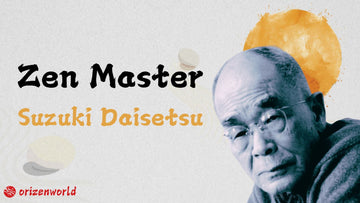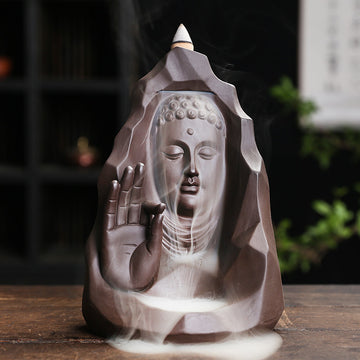A man known as the father of Zen Buddhism in Western society, Suzuki Daisetsu, revolutionized global understanding of Zen in the 20th century. With boundless passion and profound knowledge, he shared Zen philosophy across the world, influencing countless individuals, including luminaries such as Steve Jobs, Martin Heidegger, and John Cage.
For those familiar with Zen Buddhism, Suzuki Daisetsu is a name that resonates deeply. As a practitioner myself, I’ve been captivated by his works and teachings, which beautifully bridge Eastern wisdom and Western thought.
Today, I invite you to explore the remarkable story of this Zen master and the timeless ideas he championed, leaving a legacy that continues to inspire generations around the globe.
Suzuki Daisetsu (1870–1966), as known as D.T.Suzuki, was a world-renowned authority on Zen Buddhism, a distinguished Japanese scholar, and a prominent thinker. Born in Kanazawa City, Ishikawa Prefecture, into a samurai family, his birth name was Suzuki Teitaro. His father practiced Western medicine, while his mother was a devout Buddhist. In his youth, Suzuki studied Zen under the guidance of Zen masters Kosen Imakita and Shaku Soen. This period marked the beginning of his Zen journey, laying a solid foundation for his lifelong dedication to Zen.
At the age of 27, Suzuki first traveled to the United States in 1897, embarking on a mission to spread Zen teachings. Over the years, he lectured and taught extensively across the U.S. and Europe before returning to Japan in 1909. Back home, he held various academic positions, including lecturer at Gakushuin and Tokyo Imperial University, as well as professor at Otani University. He also founded the Eastern Buddhist Society and was awarded Japan's prestigious Order of Culture in 1949.
Suzuki was a prolific writer, leaving behind a remarkable body of work. His most notable publications include An Introduction to Zen Buddhism, Zen and Japanese Culture, Essays in Zen Buddhism, and Zen and Psychoanalysis. In 1970, to honor his centenary, a 32-volume collected works series, The Complete Works of Suzuki Daisetsu, was published in Japan.
Suzuki's deep understanding of both Eastern and Western philosophy allowed him to present Zen in an accessible and insightful way to global audiences, earning him the title of "Zen Master to the World."
In Zen and Japanese Culture, Suzuki provided a profound analysis of how Zen deeply influenced Japan’s art and culture, demonstrating its enduring impact on aesthetic and spiritual practices.
Suzuki Daisetsu, born Suzuki Teitaro in 1870 in Kanazawa City, Ishikawa Prefecture, hailed from a samurai family serving as physicians for the Kaga Clan. Following his father’s early death, Suzuki faced economic hardships but persisted in his education.
He formed lifelong friendships with prominent intellectuals like Nishida Kitaro and literary scholar Fujioka Sakutaro. These relationships enriched his intellectual pursuits and shaped his philosophical development, marking the beginning of his journey toward becoming a Zen master.
Suzuki’s educational path was unconventional and fraught with challenges. After enrolling at the Fourth High School in Ishikawa (now Kanazawa University), financial constraints forced him to drop out. He took a teaching job at a local elementary school but eventually resigned.
In Tokyo, he pursued studies at various institutions, including Waseda University and the University of Tokyo's Department of Philosophy, only to leave them unfinished.

Suzuki's academic setbacks reflected not a lack of intellect but a deeper yearning for spiritual fulfillment, which ultimately drew him toward Zen practice.
In 1891, Suzuki began his formal Zen training at Engaku-ji Temple in Kamakura. His spiritual journey deepened under the guidance of Imakita Kosen, a revered Zen master and the temple’s chief abbot. During their first meeting, Kosen praised the resilience often associated with men from Kanazawa, leaving a profound impression on Suzuki. He later reflected on these words as both an encouragement and a mandate to embody perseverance in his spiritual path.
This encounter proved transformative, inspiring Suzuki to abandon traditional academic pursuits in favor of dedicated Zen practice. He viewed Kosen’s words not merely as a compliment but as a spiritual directive, shaping his destiny.
By choosing Zen over conventional education, Suzuki laid the foundation for his lifelong mission: bridging Eastern spiritual wisdom with Western intellectual traditions. This decision was pivotal in his evolution into the "father of Zen Buddhism in the West."
After the passing of Imakita Kosen in 1892, Suzuki Teitaro, later known as Daisetsu, continued his Zen training under Shaku Soen (1860–1919), Kosen’s successor.
Shaku Soen, a pioneering figure who introduced the term "Zen" to the Western world, became an influential mentor in Suzuki’s spiritual and intellectual journey.
In 1894, Soen bestowed upon his disciple the name "Daisetsu" and encouraged him to broaden his horizons beyond Japan, setting the stage for a transformative phase in Suzuki’s life.
In 1897, at the age of 27, Suzuki embarked on his first journey to the United States. Working as a publisher’s editor and as an assistant to the religious philosopher Paul Carus (1852–1919), Suzuki immersed himself in a challenging yet enriching environment. These experiences cultivated his international perspective and exceptional command of English, skills that would later be instrumental in bridging Zen philosophy between East and West.
Returning to Japan after 12 years abroad, Suzuki began a new chapter as a scholar and teacher. He served as a lecturer at Gakushuin (now Gakushuin University) and the University of Tokyo before being appointed as a professor at Gakushuin. His return marked the beginning of a significant academic career, during which his students became some of his staunchest supporters, reflecting his inspiring character and teaching.

In 1903, Suzuki married Beatrice Erskine Lane, an American scholar who shared his interest in Buddhism. Their union symbolized the blending of Eastern and Western thought, mirroring Suzuki's broader mission to promote global understanding of Zen. Together, they navigated academic and cultural exchanges, further establishing Suzuki's legacy as a pivotal figure in the global dissemination of Zen philosophy.
After his time at Gakushuin, Daisetsu Suzuki, encouraged by the philosopher Nishida Kitaro and Buddhist scholar Sasaki Gakujo (1875–1926), accepted a professorship at Otani University (now Otani University) in 1921.
At Otani, Suzuki’s ideas began to mature, and he became a leading figure in the academic world. His tenure at Otani allowed him to develop his teachings further, combining Zen philosophy with Western academic thought. Suzuki also founded the Eastern Buddhist Society and, alongside his wife Beatrice and Sasaki, launched Japan’s first English-language Buddhist journal, The Eastern Buddhist. This magazine became a crucial platform for spreading Zen philosophy and establishing Suzuki’s intellectual authority in the field.
During this time, Suzuki published several notable works, including Essays in Zen Buddhism (1927) and The Spirituality of Japan, both of which were written in English and Japanese. These works helped cement his reputation as one of the foremost Zen scholars of the 20th century. His ideas began to influence not only Japan but also the wider world, as he successfully bridged Eastern and Western thought.
Behind Suzuki’s success was the unwavering support of benefactors, particularly businessman Akita Yoshi (1873–1949), who played a key role in his academic career. Akita had supported Suzuki since his earlier years, providing financial backing when Suzuki was still a relatively unknown scholar. During Suzuki’s time at Otani University, Akita offered him and his wife a residence in Kyoto and funded the publication of Suzuki’s English-language work, Zen Buddhism and Its Influence on Japanese Culture (1938).
Akita’s support was critical, especially in a time when suspicion and hostility toward foreign languages and ideas were widespread. Despite the potential risk of political backlash, Akita’s generosity allowed Suzuki to continue his work without hindrance. Without this financial support, it is unlikely that Suzuki’s influence would have spread as widely or profoundly as it did.
Suzuki’s work at Otani University marked a significant period in his career, where his teachings grew in both depth and scope. His writings, lectures, and translations of Zen philosophy brought Eastern spiritual traditions to the forefront of global intellectual discourse. Thanks to the encouragement of mentors like Nishida and the financial backing of benefactors like Akita, Suzuki’s legacy as the foremost Zen scholar in the West was solidified.
Suzuki Daisetsu's interpretation of Zen emphasizes its profound simplicity and directness, rooted in a deep connection with the reality of existence. Zen, for Suzuki, is not about complex rituals or abstract concepts. It is a spiritual practice that bridges the metaphysical depth of Indian philosophy and the practical, grounded spirituality of Chinese culture. Zen teaches us to see the world clearly, without the layers of judgment or distortion. Through its direct approach, it seeks to connect individuals to the present moment and to the essence of life itself, beyond all dualities.
At its core, Zen involves a way of life that may seem ascetic or self-denying, as seen in the simple lives of Zen monks. They often live in humble surroundings, relying on basic food and shelter. However, Suzuki emphasizes that Zen’s simplicity is not about renunciation for its own sake but about stripping away the distractions that cloud our understanding of existence. Zen monks do not renounce the world; instead, they engage with it fully, seeing the sacred in the mundane. This reflects Zen’s deeper, religious aspect: it touches the very root of existence, seeing everything as interconnected and alive with meaning.
For Suzuki, Zen does not rely on abstract theological constructs or external deities. While some critics, particularly from the Christian or Hindu traditions, may struggle to find familiar divine elements in Zen, Suzuki clarifies that Zen’s focus is not on worship but on direct experience. Zen does not rely on meditation or philosophical abstractions to explain the universe. Instead, it invites practitioners to experience reality in its raw, unmediated form, beyond concepts like “emptiness” or “truth,” which can easily become detached from lived experience.
Ultimately, Suzuki argues that Zen is not a philosophy or a religion in the traditional sense. It does not offer dogma or rituals but points to a direct, immediate experience of life. Zen’s true essence lies in its ability to help us shed the veils of thought and duality, allowing us to perceive reality as it is, free from the constraints of conceptual thinking. Zen is not a form of meditation but a way of being—of living fully, without attachment to any one idea, object, or belief. It is a path to freedom, a liberation of the mind and spirit that leads to enlightenment.
Suzuki Daisetsu's teachings on Zen emphasize the importance of embracing life's suffering to find deeper meaning. He famously said, "In suffering, let it bloom!", suggesting that through accepting hardship, one can achieve true growth.
He also believed that to attain happiness, we must first be ready to accept unhappiness, and to experience freedom, we must understand the constraints of our bodies and minds. Often, he pointed out that suffering comes not from others but from our own judgments, urging us to let go of rigid values that trap us.
Suzuki also spoke of inner peace and freedom through detachment. "If your attachment is light, even wealth cannot disturb your peace," he said, underscoring the importance of a mind free from desire. True wisdom, according to Suzuki, involves seeing oneself as a transient being, realizing that nothing is permanent or absolutely necessary.
Lastly, Suzuki stressed the harmony between humans and nature. "To practice Zen, you don’t need mountains or rivers; extinguish the fire in your heart and feel cool," he taught, emphasizing that inner calm comes from letting go of attachments. Without attachment, life becomes full of endless possibilities, free from the limits imposed by rigid expectations.







